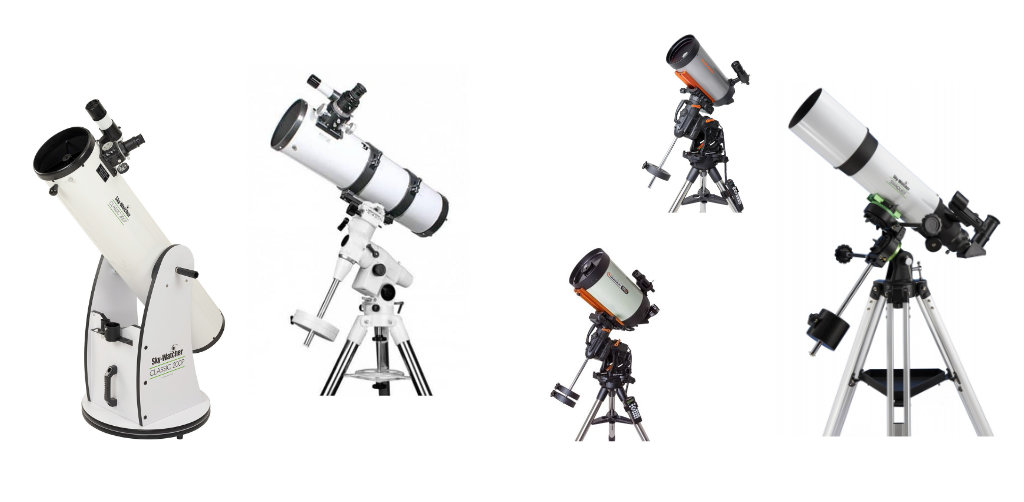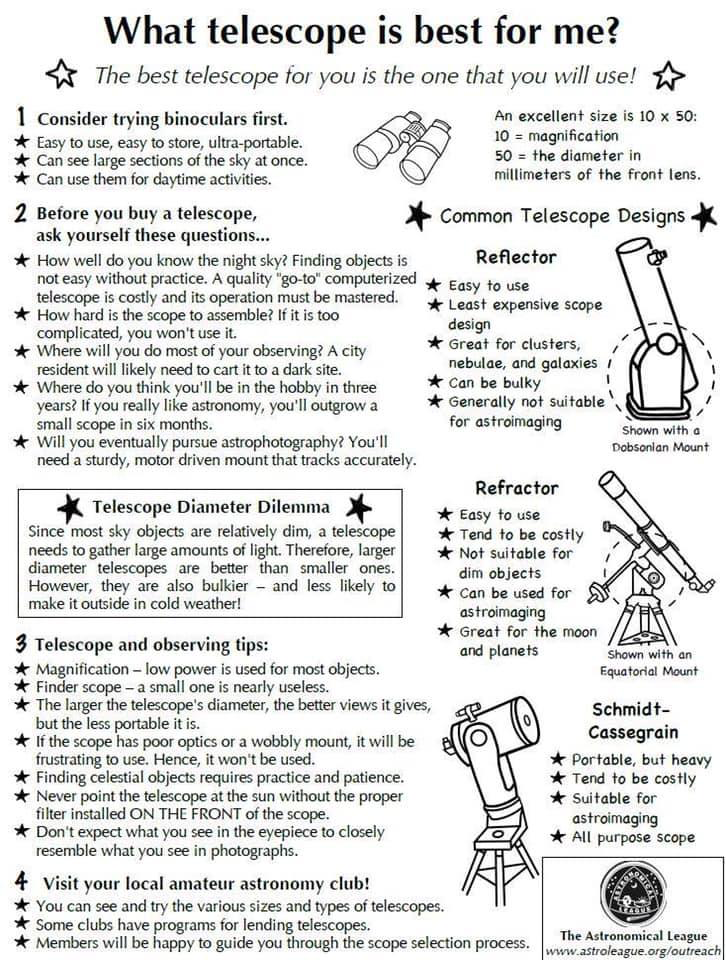
If you were asked, “what is the best car?”, how could you give a recommendation without knowing if they were planning to use it to take the kids to school, drive up dirt tracks or go racing?
Ultimately the best telescope for you is the one that you use
The Dobsonian is the ideal telescope for visual astronomy (which is where I recommend you start) and read this if you are starting out.
My suggestions
- Don’t spend too little or a massive amount on your first telescope and £200-£400 is where you should be budgeting for
- A Dobsonian reflector represents the best value for money for visual
Get a good solid, mount so avoid a tripod which will wobble with a reflector - You don’t need an equatorial mount
- Don’t get a computerised go-to mount
- Start with visual not astrophotography
- Don’t worry about the “power” of a telescope
- A wide aperture is good
- Simple is better
- Avoid cheap department store refractors
- Avoid cheaper Equatorial mounted reflectors especially Bird Jones designs
- Use a specialist astronomy retailer
- Get the advice of others from your local astronomy club
- The used market is worth considering
The bad news about buying a telescope “blind”
“It is too difficult and complicated to set up”, “I can’t see anything through it”, “The planets are too small to see anything”, “Andromeda looks nothing like the pictures on the box”, “I just can’t find a thing”
There is a chance you could end up wasting time and money on something that isn’t going to be used and will end up in the loft or on eBay.
Telescopes also make terrible “surprise” presents. The person who is going to be using it needs to be involved from the start. A copy of “Turn Left at Orion” is a much safer present.
The good news
So how can you avoid buying what’s called a “hobby killer”?
First of all, if you have been given a telescope or offered a very cheap one then fine, go for it. Be prepared to be frustrated but you will be able to see craters on the moon and learn a lot of valuable skills.
With a little reading and research, you can find a way of enjoying the night sky that you or your children will value and still enjoy many years later.
Before you buy your first telescope, I recommend you start with live, visual astronomy so forget photography until you have developed your skills. I would also avoid computerised go-to and equatorial mounts. They sound helpful but the reality is that they will add significantly to the cost and will need to be carefully set up and aligned before they can be used. With an Alt-Az mounted refractor or a Dobsonian mounted reflector, you can start observing straight away.
Binoculars are definitely worth considering, especially with a tripod as they are a very cost-effective option. They also work well in tandem with any telescope. Recommendations and more advice.
I would also avoid computerised go-to and equatorial mounts. They sound ideal but you will spend more time setting them up than actually star gazing.
Recommended advice
Vitally important is the mount or tripod. Most cheap telescopes have flimsy tripods that will shake and ruin your viewing. Cheap reflectors that have a Bird-Jones design will perform very poorly, so avoid those.
I use a pair of Olympus binoculars but the following Opticron models get good reviews from trusted people: Oregon 15x, Adventurer T WP 10×50, Oregon 10×50 WA.
A focal length of above 800mm and an aperture of at least 150mm (6”) will be a good choice for viewing different objects including planets at higher power. Smaller than this and you’ll be limited to a low-power eyepiece.
Ignore people who say “Buy an X” because without knowing your circumstances that is meaningless advice. I would read what people are using on the Stargazers Lounge and Cloudy Nights forums. Both are friendly places where you can ask questions knowing you will get helpful advice from experienced users. Do read the threads before you post though.
When you get your telescope read this.
I don’t agree with every bit of advice on the following sites but I think overall they can be trusted. It is important to do the research and get a range of opinions and that is why I have added them. Ultimately you need to come to your own conclusions but if, like me visual astronomy floats your boat then I’d go here.
- What to know before buying a telescope (Sky & Telescope)
- Hobby Killers – What telescopes not to buy (Sky & Telescope)
- Telescope Rankings – (Telescopic Watch)
- So you want to buy a telescope? (Astro-Baby)
- How to buy a telescope (National Space Centre)
- What Can You See With Different Telescopes? (Deep-Sky Watch)
- How to choose your first telescope 1 (Sky & Telescope)
- How to choose your first telescope 2 (Sky & Telescope)
- How to choose your first telescope (Sky at Night)
- What telescope should I get (r/telescopes)
- VIDEO – Choosing the “best” telescope (Ed Ting)
- VIDEO – Buying your first telescope (AstroBackyard)
- Telescope advice for children (Mile High Astro)


Good overall advice, but I disagree with your recommendation against go-to mounts: “They sound ideal but you will spend more time setting them up than actually star gazing.”
It’s actually the exact opposite. While it is certainly enriching to learn the sky, the constellations, the brightest stars, and to know their mythology, their attributes, it should not be a barrier to getting out under the sky. Starhopping is about as necessary a skill as is navigating from place to place with a road map. If you wanna drive to Milwaukee, do you consult a map? No, you let Google or Siri give you directions. You gain nothing by knowing that you have to take Route 58 for 47 miles, then turn left and take I-80 for 233 miles. It’s just no longer needed.
To use a goto, all you have to do is point the telescope at any three bright stars. You don’t have to know their names. It’s exactly that easy. It literally takes five minutes to set up – five minutes that you’d be letting the telescope cool down to the outside temperature anyway.
With a goto telescope, I can look at a dozen objects an hour for five minutes each – right out of the box. Meanwhile, a person doing starhopping will be lucky to find half that, and for a newbie, a third would be more likely.
A good example of different thinking and a why I recommend doing research before purchasing.
I have no aversion to tech and I like to use SkySafari on an iPad when observing but Goto offers no appeal or advantages to me. Star hopping is part of the fun of learning the night sky is an important aspect of the hobby that I really enjoy. I would also spend a limited budget on quality optics than electronic hardware.
I’d recommend SkEye and it’s push to mode if a user wants to get an idea of tech assistance without having to spend lots of money.
As I say, what works for me may not work for you. I am in no rush to tick off my target list and am happy with a slow and minimalist approach.
Thank you for posting.
I sold all my gear a few years ago. I had an 6 inch Dob then a 10 inch (very hard to transport) then a couple of SCT. The latest being an 8 inch Celestron with a go-to mount including an alignment camera and a ZWO eyepiece camera. My wife would shake her head at my latest addition and ask me about the cost. What ever you do don’t start off on the astrophotography route, it is too much of a learning curve and can be addictive and frustrating. Get observing first. I have taken up sketching through the eyepiece as a spin off from astronomy. I agree with Brett’s sage advice keep it simple at the beginning. I started the hobby up again recently, and by a complete coincidence, I have EXACTLY the same gear as Brett!
I believe most people who don’t like star hopping have never tried it with a nice 40mm 2″ eyepiece. The views of finding the target are quite enjoyfull by themselves. I love IT and technology but I am never going to get a Go-To.. No need at all when I can find anything in a minute with my 40mm 2″ (on an 8″ DOB). If I do spend more money, it will be on a 12″.